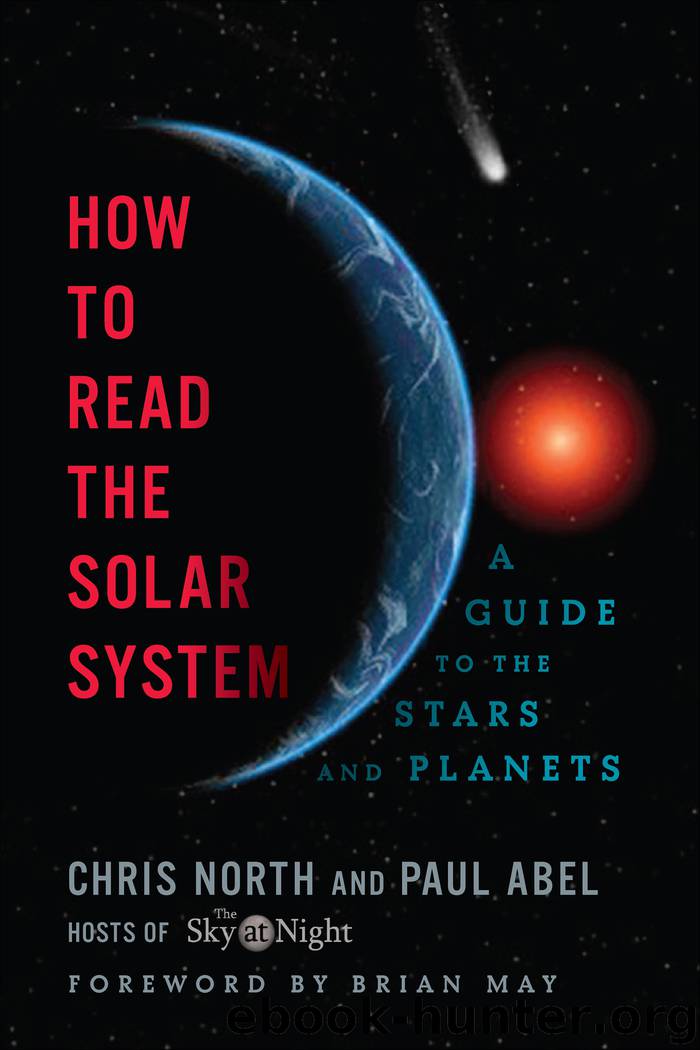How to Read the Solar System by Paul Abel

Author:Paul Abel
Language: eng
Format: epub
Publisher: Pegasus
Published: 2014-04-07T16:00:00+00:00
Victoria Crater as seen by the Opportunity rover.
The discoveries by Spirit and Opportunity have been remarkable, largely thanks to their longevity but also because they carry a sophisticated suite of experiments for investigating the physical properties of Mars. Their successor, however, is a huge leap forwards. Mars Science Laboratory, consisting of the Curiosity rover, is the size of a small car, weighs in at just under a tonne, and carries ten experiments designed to look at the chemistry of the Martian surface. It landed in August 2012 using a novel technique which combined aerobraking in the atmosphere, the use of a parachute, and finally a ‘sky crane’, which hovered above the surface on thrusters before flying off to crash a few hundred metres away. Using this powered descent allowed Curiosity to be five times heavier than its predecessors, while having the thrusters on the overhead jetpack meant that it landed on its wheels, ready and raring to rove. Rather than being solar powered, Curiosity uses a radioisotope thermal generator, which generates power from the decay of radioactive plutonium. This is similar to the power generation on the Viking landers and any probes that have ventured into the outer Solar System and, while it doesn’t generate any more power than Spirit and Opportunity’s solar panels, it allows the rover to operate at night and is not susceptible to the build-up of dust. This allows the mission lifetime to be much longer, at two years, with a planned driving distance of 20 kilometres – though if previous missions are anything to go by it may well outperform on both of those criteria.
Curiosity’s instruments include ChemCam, a powerful laser capable of vaporising small amounts of Martian dust and rock up to 7 metres away, which is analysed by a detector that measures the composition of the vaporised material. This not only means that Curiosity can study rocks that might be in inaccessible locations (such as up a cliff face), but also allows the mission operators to pre-select the rocks they want to drive up to and study further. At the end of its 2-metre robot arm are a camera capable of taking microscopic image, an X-ray spectrometer that allows the composition of the rocks to be analysed, and a set of tools for drilling into the surface and collecting material. This material is then transferred to the chemical laboratories in the main body of the rover, where advanced instruments analyse the minerals in the samples and look for the presence of organic compounds. These organic chemicals, which contain a combination of carbon, hydrogen and oxygen, are thought to be a prerequisite of life, and Curiosity’s chemistry experiments will be able to detect whether the compounds are present, and determine the conditions in which the rocks they are found in were formed. It is this ability which will help Curiosity succeed in its primary mission, which is to determine whether early Mars was a habitable place or not, though it is unlikely to be able to determine whether there was life present – that will have to wait for future missions.
Download
This site does not store any files on its server. We only index and link to content provided by other sites. Please contact the content providers to delete copyright contents if any and email us, we'll remove relevant links or contents immediately.
| Aeronautics & Astronautics | Astronomy |
| Astrophysics & Space Science | Comets, Meteors & Asteroids |
| Cosmology | Mars |
| Solar System | Star-Gazing |
| Telescopes | UFOs |
Tools of Titans by Timothy Ferriss(8306)
Turbulence by E. J. Noyes(7981)
Secrets of Antigravity Propulsion: Tesla, UFOs, and Classified Aerospace Technology by Ph.D. Paul A. Laviolette(5335)
Astrophysics for People in a Hurry by Neil DeGrasse Tyson(5152)
Room 212 by Kate Stewart(5073)
Design of Trajectory Optimization Approach for Space Maneuver Vehicle Skip Entry Problems by Runqi Chai & Al Savvaris & Antonios Tsourdos & Senchun Chai(5039)
Pale Blue Dot by Carl Sagan(4960)
The David Icke Guide to the Global Conspiracy (and how to end it) by David Icke(4658)
A Journey Through Divination and Astronomy by Publishing Pottermore(4364)
Goodbye Paradise(3763)
Apollo 8 by Jeffrey Kluger(3671)
COSMOS by Carl Sagan(3590)
The Five People You Meet in Heaven by Mitch Albom(3521)
Losing the Nobel Prize by Brian Keating(3520)
How to Read Water: Clues and Patterns from Puddles to the Sea (Natural Navigation) by Tristan Gooley(3434)
Brief Answers to the Big Questions by Stephen Hawking(3394)
How to Read Nature by Tristan Gooley(3294)
The Order of Time by Carlo Rovelli(3163)
A Brief History of Time by Stephen Hawking(2994)
